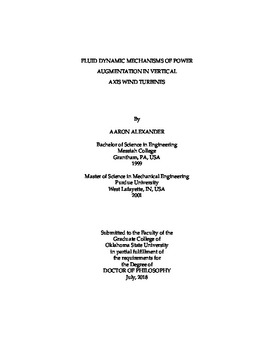| dc.contributor.advisor | Santhanakrishnan, Arvind | |
| dc.contributor.author | Alexander, Aaron | |
| dc.date.accessioned | 2019-03-20T18:35:40Z | |
| dc.date.available | 2019-03-20T18:35:40Z | |
| dc.date.issued | 2018-07 | |
| dc.identifier.uri | https://hdl.handle.net/11244/317601 | |
| dc.description.abstract | Using computational fluid dynamics (CFD) simulations, this study examines passive flow control in drag-based and lift-based vertical axis wind turbines (VAWT). In drag based VAWTs (D-VAWT) such as the Savonius wind turbine, the use of a stator enclosure with non-moving blades for the purpose of channeling flow into the VAWT was found to generate high pressures upstream of the stator. The stator successfully increased power output, but the power augmentation was limited because the upstream pressure field influences flow to divert around the VAWT. The observed power output was lower than would generated by a rotor with the same diameter as the stator. In contrast, lift based VAWTs (L-VAWT) such as the Darrieus wind turbine have been shown to channel flow when counter-rotating pairs of L-VAWTs are located in close proximity. This study found that power augmentation in two side-by-side L-VAWTs primarily occurs due to a reduction in bypass flow (volumetric flow rate of air entering the rotor relative to unobstructed free stream flow). In a typical L-VAWT, the rotation of the rotor blades creates a high-pressure field upstream of the rotor as it removes energy from the wind and slows down the airflow that passes through the rotor. Normally, this high-pressure field re-directs on the order of 50% of the incoming air volume around the turbine reducing the potential power output of the turbine. When two counter-rotating L-VAWTs were placed in close proximity, this study found that the bypass flow that would normally pass to the side of the adjacent turbine was re-directed back into the rotor, reducing the total bypass by around 10% while generating up to 13.6% more power. Thus, the same mechanism that limited power augmentation in D-VAWTs contributed to power augmentation in L-VAWTs. An additional power augmentation mechanism for L-VAWTs was studied by intermeshing the adjacent L-VAWT rotors together like a set of gears. Power augmentation was found to exceed the augmentation previously reported in counter-rotating L-VAWTs separated by a gap. This power augmentation was accomplished without further reducing bypass flow. | |
| dc.format | application/pdf | |
| dc.language | en_US | |
| dc.rights | Copyright is held by the author who has granted the Oklahoma State University Library the non-exclusive right to share this material in its institutional repository. Contact Digital Library Services at lib-dls@okstate.edu or 405-744-9161 for the permission policy on the use, reproduction or distribution of this material. | |
| dc.title | Fluid dynamic mechanisms of power augmentation in vertical axis wind turbines | |
| dc.contributor.committeeMember | Jacob, Jamey | |
| dc.contributor.committeeMember | Sallam, Khaled | |
| dc.contributor.committeeMember | Stadler, Stephen | |
| osu.filename | Alexander_okstate_0664D_15820.pdf | |
| osu.accesstype | Open Access | |
| dc.type.genre | Dissertation | |
| dc.type.material | Text | |
| thesis.degree.discipline | Mechanical and Aerospace Engineering | |
| thesis.degree.grantor | Oklahoma State University | |
